Abstract
Objective:
To investigate the effect of icing the arm and shoulder between weight-pulling sets on work, velocity, and power.
Design and Setting:
I used a 1 × 2 factorial, random, counterbalanced design in which each participant pulled 75‰ of his 1-repetition maximum on 2 separate days. The individuals pulled the weight 22 times for each set as fast as possible, then either iced (cryotherapy) or placed towels over their arms and shoulders for 3 minutes, and then rested 4.5 minutes at room temperature. The sets continued until the participants could not complete 22 pulls without stopping.
Subjects:
Ten male members of a private athletic club, who weight lift on a regular basis, volunteered to participate in the study.
Measurements:
Work was determined by the number of arm-pull sets completed before fatigue, velocity was measured by the time to complete each set, and power was determined by dividing work by velocity. Velocity and power were analyzed in 3 ways: first to fourth sets (88 pulls), matched sets (167.2 pulls), and all sets (191.4 cryotherapy and 167.2 towel pulls), using analysis of covariance with the base set as the covariate.
Results:
Cryotherapy between sets resulted in a significantly greater number of total joules and arm pulls when compared with the towel treatment. Velocity was significantly faster for the first to fourth sets, matched sets, and all sets when subjects received intermittent cryotherapy. Power also was significantly higher for the first to fourth sets and matched sets. The all-sets comparison consisted of 14.5‰ more cryotherapy arm pulls.
Conclusions:
Interval cryotherapy between weight-pulling sets is associated with increased work, velocity, and power.
Keywords: cold, ice, strength, work, velocity, power
Full text
PDF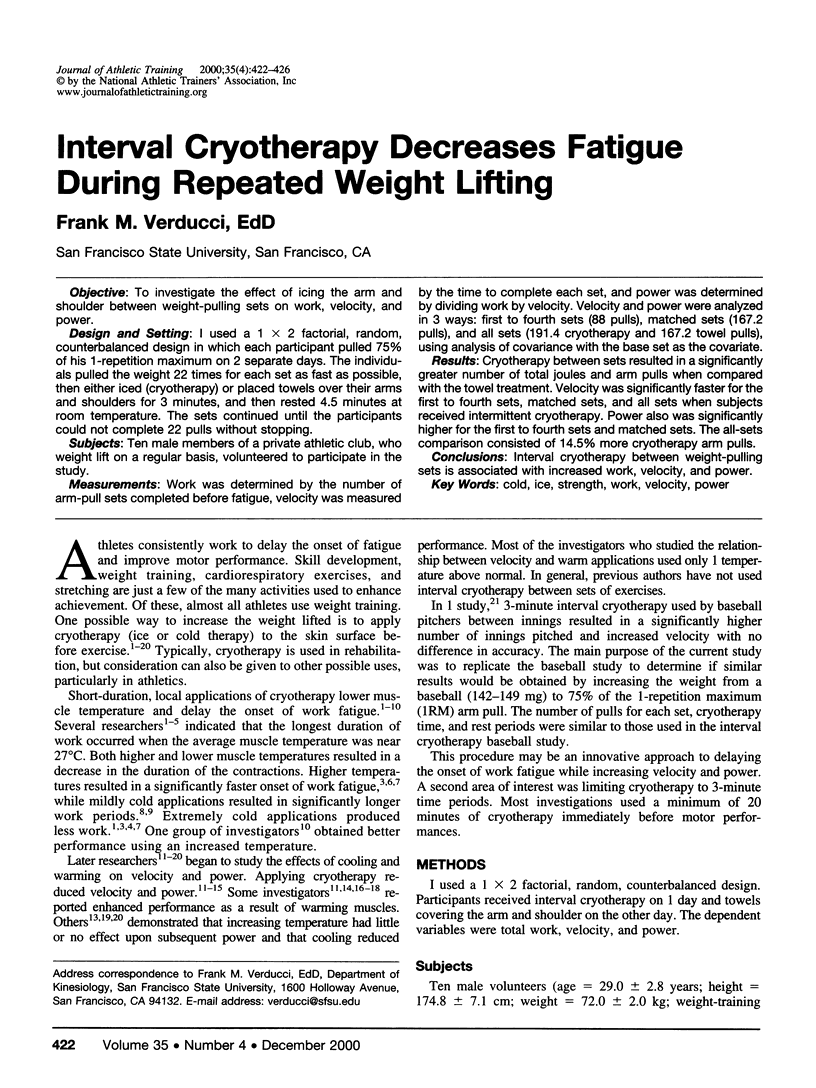
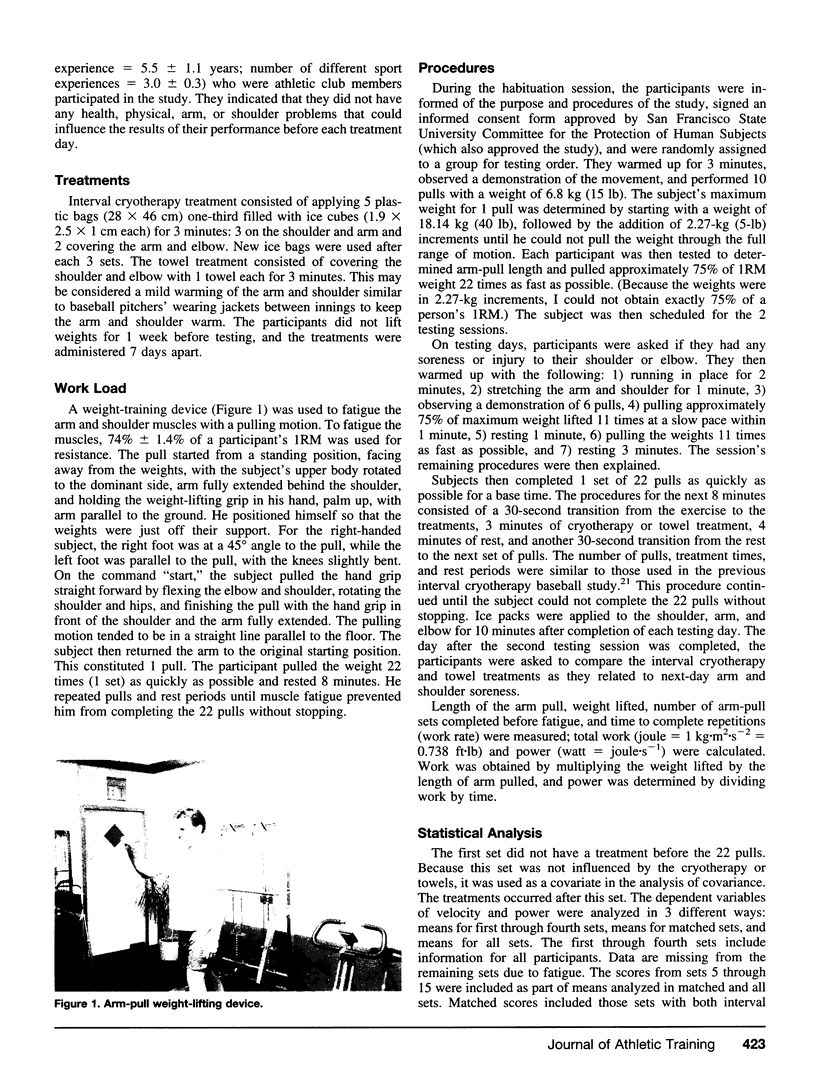
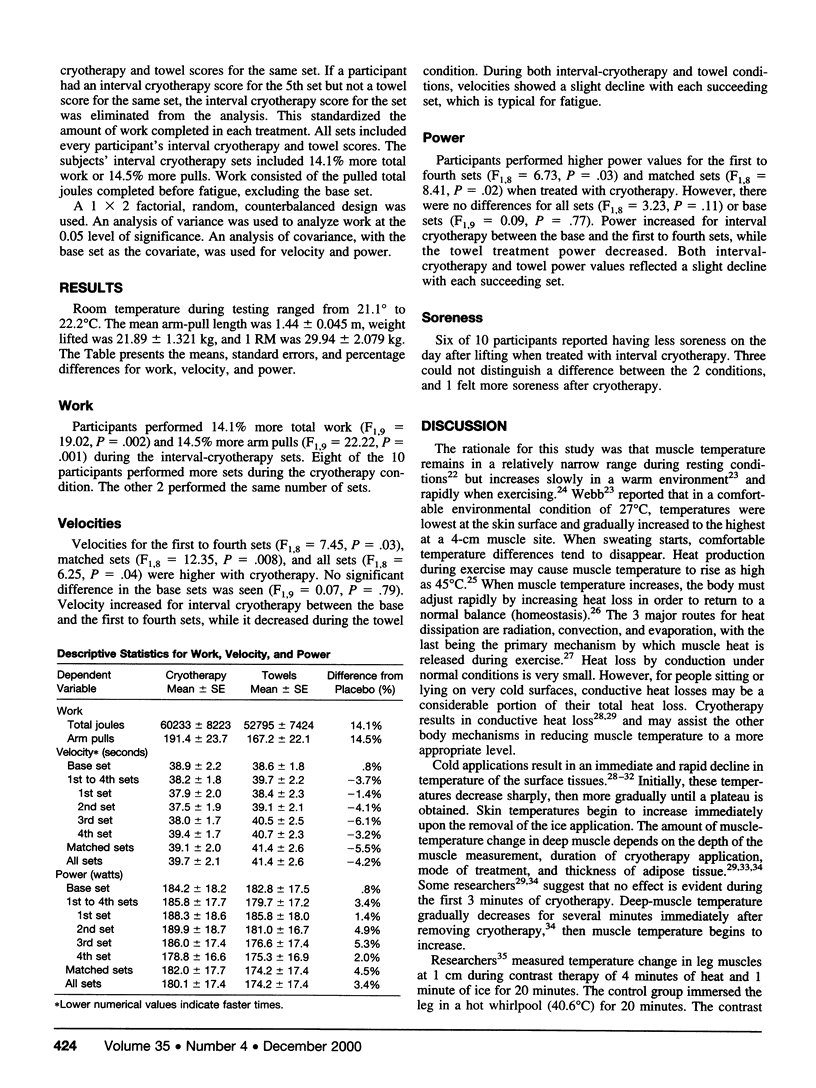
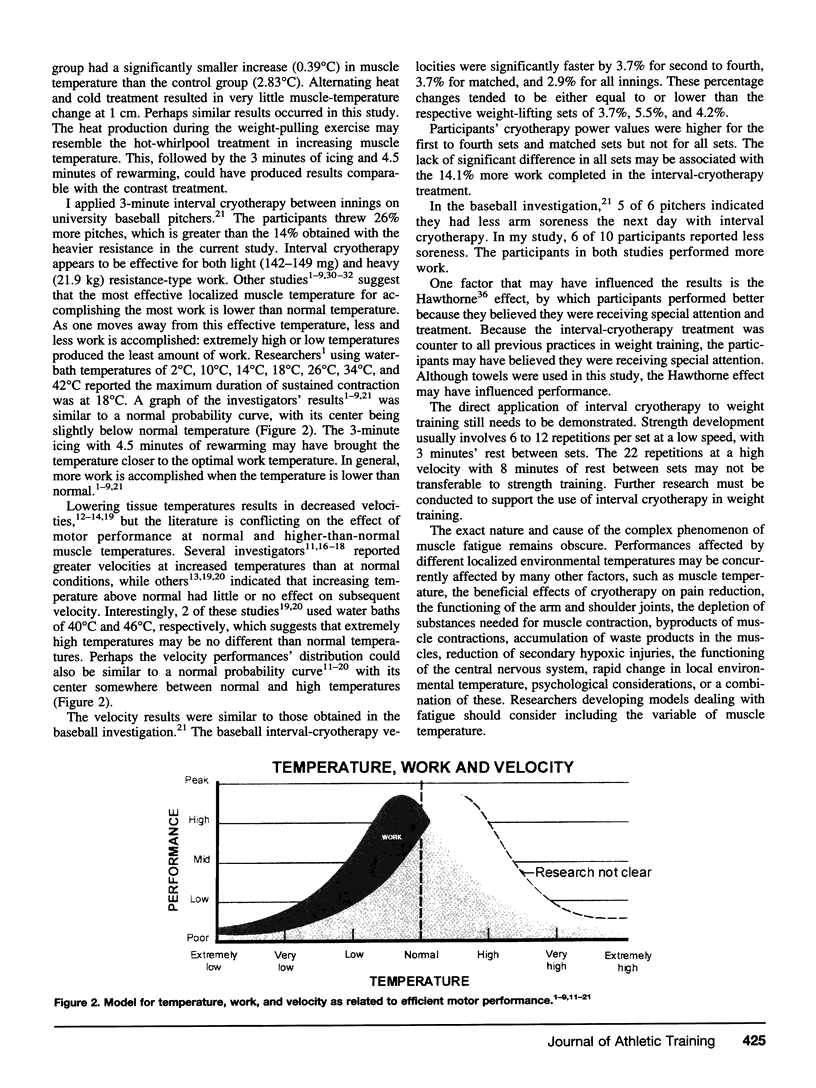
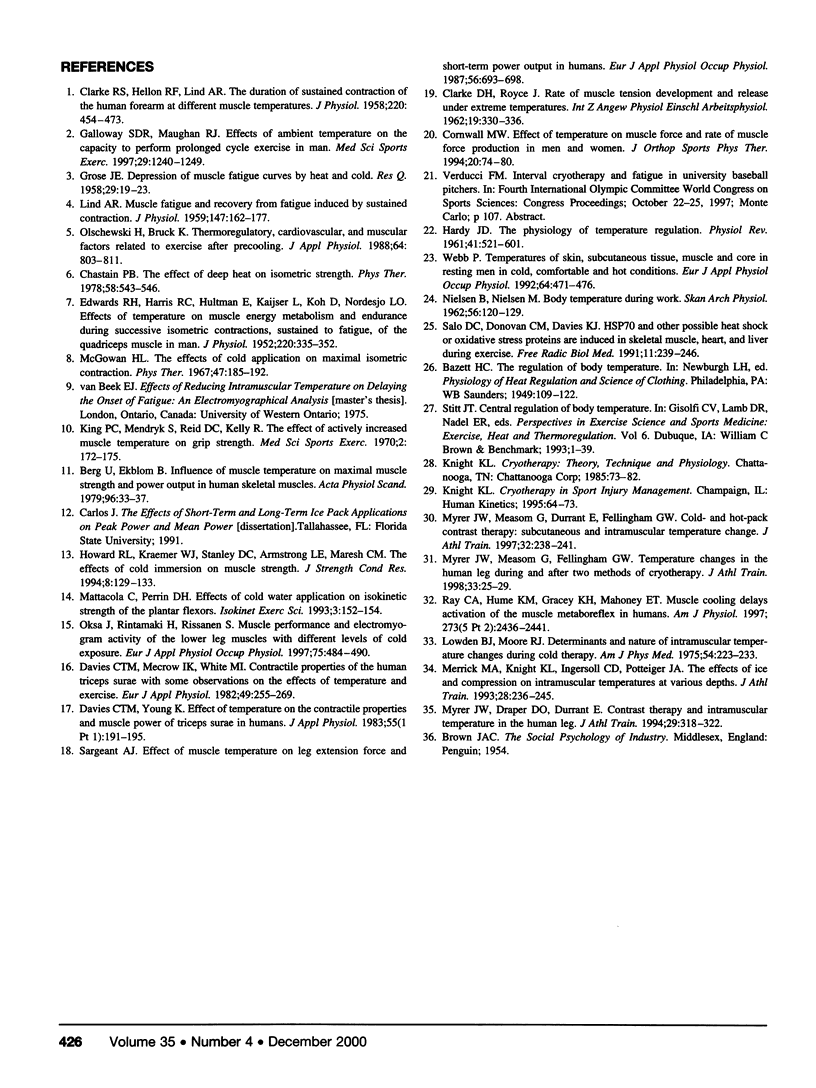
Images in this article
Selected References
These references are in PubMed. This may not be the complete list of references from this article.
- Bergh U., Ekblom B. Influence of muscle temperature on maximal muscle strength and power output in human skeletal muscles. Acta Physiol Scand. 1979 Sep;107(1):33–37. doi: 10.1111/j.1748-1716.1979.tb06439.x. [DOI] [PubMed] [Google Scholar]
- CLARKE D. H., ROYCE J. Rate of muscle tension development and release under extreme temperatures. Int Z Angew Physiol. 1962;19:330–336. doi: 10.1007/BF00694275. [DOI] [PubMed] [Google Scholar]
- CLARKE R. S., HELLON R. F., LIND A. R. The duration of sustained contractions of the human forearm at different muscle temperatures. J Physiol. 1958 Oct 31;143(3):454–473. doi: 10.1113/jphysiol.1958.sp006071. [DOI] [PMC free article] [PubMed] [Google Scholar]
- Chastain P. B. The effect of deep heat on isometric strength. Phys Ther. 1978 May;58(5):543–546. doi: 10.1093/ptj/58.5.543. [DOI] [PubMed] [Google Scholar]
- Cornwall M. W. Effect of temperature on muscle force and rate of muscle force production in men and women. J Orthop Sports Phys Ther. 1994 Aug;20(2):74–80. doi: 10.2519/jospt.1994.20.2.74. [DOI] [PubMed] [Google Scholar]
- Davies C. T., Mecrow I. K., White M. J. Contractile properties of the human triceps surae with some observations on the effects of temperature and exercise. Eur J Appl Physiol Occup Physiol. 1982;49(2):255–269. doi: 10.1007/BF02334074. [DOI] [PubMed] [Google Scholar]
- Davies C. T., Young K. Effect of temperature on the contractile properties and muscle power of triceps surae in humans. J Appl Physiol Respir Environ Exerc Physiol. 1983 Jul;55(1 Pt 1):191–195. doi: 10.1152/jappl.1983.55.1.191. [DOI] [PubMed] [Google Scholar]
- Edwards R. H., Harris R. C., Hultman E., Kaijser L., Koh D., Nordesjö L. O. Effect of temperature on muscle energy metabolism and endurance during successive isometric contractions, sustained to fatigue, of the quadriceps muscle in man. J Physiol. 1972 Jan;220(2):335–352. doi: 10.1113/jphysiol.1972.sp009710. [DOI] [PMC free article] [PubMed] [Google Scholar]
- Galloway S. D., Maughan R. J. Effects of ambient temperature on the capacity to perform prolonged cycle exercise in man. Med Sci Sports Exerc. 1997 Sep;29(9):1240–1249. doi: 10.1097/00005768-199709000-00018. [DOI] [PubMed] [Google Scholar]
- HARDY J. D. Physiology of temperature regulation. Physiol Rev. 1961 Jul;41:521–606. doi: 10.1152/physrev.1961.41.3.521. [DOI] [PubMed] [Google Scholar]
- King P. G., Mendryk S., Reid D. C., Kelly R. The effect of actively increased muscle temperature on grip strength. Med Sci Sports. 1970 Fall;2(3):172–175. [PubMed] [Google Scholar]
- LIND A. R. Muscle fatigue and recovery from fatigue induced by sustained contractions. J Physiol. 1959 Jun 23;147(1):162–171. doi: 10.1113/jphysiol.1959.sp006231. [DOI] [PMC free article] [PubMed] [Google Scholar]
- Lowdon B. J., Moore R. J. Determinants and nature of intramuscular temperature changes during cold therapy. Am J Phys Med. 1975 Oct;54(5):223–233. [PubMed] [Google Scholar]
- McGown H. L. Effects of cold application on maximal isometric contraction. Phys Ther. 1967 Mar;47(3):185–192. doi: 10.1093/ptj/47.3.185. [DOI] [PubMed] [Google Scholar]
- Merrick M. A., Knight K. L., Ingersoll C. D., Potteiger J. A. The effects of ice and compression wraps on intramuscular temperatures at various depths. J Athl Train. 1993 Fall;28(3):236–245. [PMC free article] [PubMed] [Google Scholar]
- Myrer J. W., Draper D. O., Durrant E. Contrast therapy and intramuscular temperature in the human leg. J Athl Train. 1994 Dec;29(4):318–322. [PMC free article] [PubMed] [Google Scholar]
- Myrer J. W., Measom G., Durrant E., Fellingham G. W. Cold- and hot-pack contrast therapy: subcutaneous and intramuscular temperature change. J Athl Train. 1997 Jul;32(3):238–241. [PMC free article] [PubMed] [Google Scholar]
- Myrer J. W., Measom G., Fellingham G. W. Temperature changes in the human leg during and after two methods of cryotherapy. J Athl Train. 1998 Jan;33(1):25–29. [PMC free article] [PubMed] [Google Scholar]
- NIELSEN B., NIELSEN M. Body temperature during work at different environmental temperatures. Acta Physiol Scand. 1962 Oct;56:120–129. doi: 10.1111/j.1748-1716.1962.tb02489.x. [DOI] [PubMed] [Google Scholar]
- Oksa J., Rintamäki H., Rissanen S. Muscle performance and electromyogram activity of the lower leg muscles with different levels of cold exposure. Eur J Appl Physiol Occup Physiol. 1997;75(6):484–490. doi: 10.1007/s004210050193. [DOI] [PubMed] [Google Scholar]
- Olschewski H., Brück K. Thermoregulatory, cardiovascular, and muscular factors related to exercise after precooling. J Appl Physiol (1985) 1988 Feb;64(2):803–811. doi: 10.1152/jappl.1988.64.2.803. [DOI] [PubMed] [Google Scholar]
- Salo D. C., Donovan C. M., Davies K. J. HSP70 and other possible heat shock or oxidative stress proteins are induced in skeletal muscle, heart, and liver during exercise. Free Radic Biol Med. 1991;11(3):239–246. doi: 10.1016/0891-5849(91)90119-n. [DOI] [PubMed] [Google Scholar]
- Sargeant A. J. Effect of muscle temperature on leg extension force and short-term power output in humans. Eur J Appl Physiol Occup Physiol. 1987;56(6):693–698. doi: 10.1007/BF00424812. [DOI] [PubMed] [Google Scholar]
- Webb P. Temperatures of skin, subcutaneous tissue, muscle and core in resting men in cold, comfortable and hot conditions. Eur J Appl Physiol Occup Physiol. 1992;64(5):471–476. doi: 10.1007/BF00625070. [DOI] [PubMed] [Google Scholar]




